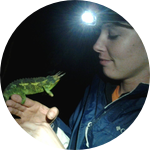About This Project
Jackson’s Chameleons are charismatic lizards that are popular in the pet trade due to a number of unique features, including color change ability, tongue strike feeding, and horns in males. Although chameleon horns are thought to function as ornaments and weapons, the underlying biology and genetics remain uncharacterized. We will examine the genetic and functional bases of horn development and use in Jackson’s chameleons via DNA sequencing and behavioral contest trials in males.
Ask the Scientists
Join The DiscussionWhat is the context of this research?
Horns are conspicuous projections on the heads of many animals, from beetles to buffalo. These structures are thought to have multiple functions, including territorial combat, predator defense, and attracting mates. However, structures with shared functions between animals as distantly related as insects and vertebrates are usually thought to be analogous, the result of convergent evolutionary forces on structures with different genetic and embryological origins, rather than homologous, or shared by descent from a common ancestor. Recent molecular studies have begun to characterize the loci that control horn growth in mammals. The hypothesis that we will test is that horns in vertebrates, namely ungulates and chameleons, are genetically and behaviorally homologous.
What is the significance of this project?
Sexual selection, or competition for mates, leads to differential reproductive success, which is a critical driver of speciation. Speciation is in turn the force that maintains global biodiversity in the face of extinction. The factors that lead to biological diversification continue to be a rich source of ongoing scientific research. Despite the diversity of the family Chameleonidae, with about 200 species, as well as their fascinating and highly derived anatomical and biological adaptations, they remain relatively under-studied although they play important ecological roles in arboreal food webs. We are interested in the factors that have led to diversification within this lineage, and what lessons can be elucidated and applied to other animals with prominent weaponry.
What are the goals of the project?
The short-term goals of this project are to determine the genetic and functional bases of horns in chameleons. We will do this by 1) using PCR primers designed for mammalian horn genes to search for homologous loci in the Jackson’s chameleon, and 2) setting up staged behavioral contests among males with different horn/SVL ratios, to test the idea that longer horns are the best predictor of contest success. Our results will provide critical information for our long term research goals which involve examining the evolution of sexual characters and weapons across the entire Chamaeleonidae family, in addition to the role that sexual characters and weapons play in speciation in this very unique, though poorly characterized group.
Budget
To determine the genetic basis of horns in chameleons, we will collect chameleon tissue from live specimens from wild invasive populations in Hawaii and preserve tissue and specimens in ethanol. Then, using the DNeasy tissue kit, we will extract DNA, and then build primers for the RXFP2 gene based on similar sequences in other reptiles. Using the primers and Taq Master mix, we will perform PCR to replicate the RXFP2 gene in chameleons, then isolate and sequence the gene to compare it to the same gene sequenced for multiple vertebrate species. To determine the function of horns in chameleons, we will capture wild male chameleons of different size and horn lengths, keep them in small butterfly cages, then pair up males in behavioral contests to test the hypothesis that horn length predicts the outcome of contests.
Endorsed by
Meet the Team
Team Bio
Our team includes undergraduate and graduate students of the Hawaiian Biodiversity and Conservation Lab at the University of Hawaii Manoa, including international interns and volunteers across disciplines. Our team is committed to performing research studies involving the conservation of native and endemic fauna in Hawaii, which includes studies on devastating predatory invasive species such as the Jackson's chameleon.
Melissa Jane Van Kleeck-Hann
I am a recent doctoral graduate from the University of Hawaii Manoa's Hawaiian Tree Snail Conservation Lab (May 2016), and previous graduate from Truman State University in Kirksville, Mo (August 2012, May 2010). I've been working with reptiles and amphibians throughout my undergraduate and graduate careers from boas and pythons to chameleons and frogs, including basic husbandry and community outreach education at Truman State University's Herpetarium, and invasion ecology research on predatory herpetofauna in Hawaii. My Master's thesis focused on morphological variation and taxonomic assessment of Boa constrictors, while my dissertation involved invasion ecology of Jackson's chameleons. My current research interests range broadly from rapid adaptation in invasive species to animal behavior and how sexual selection can drive speciation.
Project Backers
- 6Backers
- 7%Funded
- $70Total Donations
- $11.67Average Donation

